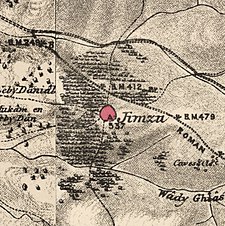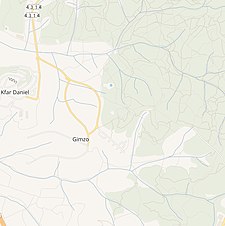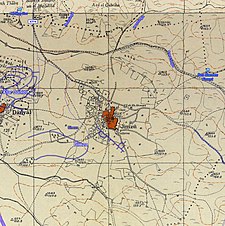Jimzu
Jimzu
جمزو Gimzo | ||
|---|---|---|
| Etymology: Sycamore[1] | ||
A series of historical maps of the area around Jimzu (click the buttons) | ||
Geopolitical entity Mandatory Palestine | | |
| Subdistrict | Ramle | |
| Date of depopulation | 10 July 1948[4] | |
| Area | ||
| • Total | 9,681 dunams (9.681 km2 or 3.738 sq mi) | |
| Population (1945) | ||
| • Total | 1,510[2][3] | |
| Cause(s) of depopulation | Military assault by Yishuv forces | |
| Current Localities | Moshav Gimzo[5] | |
Jimzu (
Under the 1949 Armistice Agreements, Jimzu's lands fell under the de facto governance of the newly created state of Israel. A year later, moshav Gimzo was established at the site of the former village and is now populated by 700 Israeli Jewish residents.
History
Jimzu is identified with the ancient Gimzo, a city mentioned in the Bible as being in the plain of Judah whose villages were seized by the Philistines (as recorded in the 2 Chronicles 28:18).[7] The town was home to the
Ottoman era
Jimzu, along with the whole of
Biblical scholar Edward Robinson passed through the village in 1838, and reported it to be "rather large", situated on an eminence, "to make quite a show at a distance". He also noted that the village had many subterranean magazines for storing grain.[10] It was noted as being situated in the Ramleh district.[11]
In 1863 Victor Guérin found the village have 400 inhabitants, and to be surrounded by olive and palm trees. The village also had a Makam for a Sidi Ahmed. Each family had its own silo.[12]
An Ottoman village list of about 1870 counted 83 houses and a population of 325 in Dschimzu, though the population count included men, only.[13][14]
In 1882, the PEF's Survey of Western Palestine (SWP) described Jimzu as a village built of adobe bricks and situated on the side of a low hill, surrounded by cactus hedges and olive trees.[15]
British Mandate era
In the
The villagers of Jimzu maintained a mosque. An elementary school was established in the village in 1920, and by the mid-1940s it had 175 students.[18]
Most villagers worked in agriculture.[18] In the 1945 statistics, the population was 1,510, all Muslims,[2] while the total land area was 9,681 dunams, according to an official land and population survey.[3] Of this, a total of 77 dunums was devoted to citrus and bananas, while 5,577 dunums were allocated to cereals. 1,605 dunums were irrigated or used for orchards, of which 1,400 dunums was for olives,[18][19] while 50 dunams were classified as built-up public areas.[20]
-
Jimzu 1942 1:20,000
-
Jimzu 1945 1:250,000
-
Palestinian villages depopulated in the area around Lydda and Ramla (coloured in green)
1948 war
Jizmu was occupied by the
According to
The following day (11 July) Yiftach informed Dani Headquarters, that its forces had conquered Jimzu and Daniyal and were "busy clearing the villages and blowing up the houses ['oskot betihur hakfarim u'fitzutz habatim]"[23] All of Jimzu's inhabitants left as a result of the assault by Israeli forces. Its 434 homes were demolished on September 13, 1948.[21]
The settlement of Gimzo was established on village land in 1950.[5] Palestinian historian Walid Khalidi described the remains of Jimzu in 1992: "All that remains of the houses are stones, strewn over the site, and some crumbled walls. The site is overgrown with shrubs and thorny plants. Other kind of vegetation also grow on village land, including Christ's-thorn trees, foxtail, cactuses, and some abandoned olive trees."[5]
See also
- Depopulated Palestinian locations in Israel
- List of villages depopulated during the Arab-Israeli conflict
References
- ^ Palmer, 1881, p. 230
- ^ a b Department of Statistics, 1945, p. 29
- ^ a b c Government of Palestine, Department of Statistics. Village Statistics, April, 1945. Quoted in Hadawi, 1970, p. 67
- ^ Morris, 2004, p. xix, village #230. Also gives cause of depopulation.
- ^ a b c Khalidi, 1992, p. 387
- ^ Map of UN Partition Plan Archived 2009-01-24 at the Wayback Machine
- ^ "Gimzo ... Glass". The Illustrated Bible Dictionary. Archived from the original on 2011-06-12. Retrieved 2007-12-03.
- ISBN 978-90-04-17838-0. Retrieved 5 June 2011.
- ^ Hütteroth and Abdulfattah, 1977, p. 152. Quoted in Khalidi, 1992, p. 386
- ^ Robinson and Smith, 1841, vol. 3, p. 56. Also cited in Khalidi, 1992, p. 386.
- ^ Robinson and Smith, 1841, vol. 3, 2nd appendix, p. 121
- ^ Guérin, 1868, pp. 335-336
- ^ Socin, 1879, p. 153 Also noted it to be in the Ramle district
- ^ Hartmann, 1883, p. 140, also noted 83 houses
- ^ Conder and Kitchener, 1882, SWP II, p. 297, Quoted in Khalidi, 1992, p. 386
- ^ Barron, 1923, Table VII, Sub-district of Ramleh, p. 22
- ^ Mills, 1932, p. 20.
- ^ a b c Khalidi, 1992, p. 386
- ^ Government of Palestine, Department of Statistics. Village Statistics, April, 1945. Quoted in Hadawi, 1970, p. 115
- ^ Government of Palestine, Department of Statistics. Village Statistics, April, 1945. Quoted in Hadawi, 1970, p. 165
- ^ a b "Jizmu:District of al-Ramla". Palestine Remembered. Retrieved 2007-12-03.
- ^ Morris, 2004, p. 435
- ^ Yiftah HQ\Intelligence to Dani HQ, etc., 11 July 1948, IDFA 922\75\\1237. Quoted in Morris, 2004, p. 435
Bibliography
- Barron, J. B., ed. (1923). Palestine: Report and General Abstracts of the Census of 1922. Government of Palestine.
- Conder, C.R.; Kitchener, H.H. (1882). The Survey of Western Palestine: Memoirs of the Topography, Orography, Hydrography, and Archaeology. Vol. 2. London: Committee of the Palestine Exploration Fund.
- ISBN 0-860549-05-4. p.834
- Department of Statistics (1945). Village Statistics, April, 1945. Government of Palestine.
- Guérin, V. (1868). Description Géographique Historique et Archéologique de la Palestine (in French). Vol. 1: Judee, pt. 1. Paris: L'Imprimerie Nationale.
- Hadawi, S. (1970). Village Statistics of 1945: A Classification of Land and Area ownership in Palestine. Palestine Liberation Organization Research Center.
- Hartmann, M. (1883). "Die Ortschaftenliste des Liwa Jerusalem in dem türkischen Staatskalender für Syrien auf das Jahr 1288 der Flucht (1871)". Zeitschrift des Deutschen Palästina-Vereins. 6: 102–149.
- Hütteroth, Wolf-Dieter; Abdulfattah, Kamal (1977). Historical Geography of Palestine, Transjordan and Southern Syria in the Late 16th Century. Erlanger Geographische Arbeiten, Sonderband 5. Erlangen, Germany: Vorstand der Fränkischen Geographischen Gesellschaft. ISBN 3-920405-41-2.
- ISBN 0-88728-224-5.
- Mills, E., ed. (1932). Census of Palestine 1931. Population of Villages, Towns and Administrative Areas. Jerusalem: Government of Palestine.
- ISBN 978-0-521-00967-6.
- Palmer, E. H. (1881). The Survey of Western Palestine: Arabic and English Name Lists Collected During the Survey by Lieutenants Conder and Kitchener, R. E. Transliterated and Explained by E.H. Palmer. Committee of the Palestine Exploration Fund.
- Robinson, E.; Smith, E. (1841). Biblical Researches in Palestine, Mount Sinai and Arabia Petraea: A Journal of Travels in the year 1838. Vol. 3. Boston: Crocker & Brewster.
- Socin, A. (1879). "Alphabetisches Verzeichniss von Ortschaften des Paschalik Jerusalem". Zeitschrift des Deutschen Palästina-Vereins. 2: 135–163.
External links
- Welcome to Jimzu
- Jimzu, Zochrot
- Survey of Western Palestine, Map 14: IAA, Wikimedia commons
- Carob, Fennel, and the Red Soil of Gimzo: Crafting Palestinian Identity







